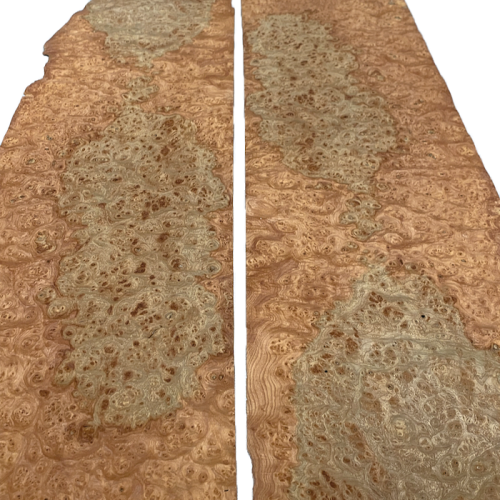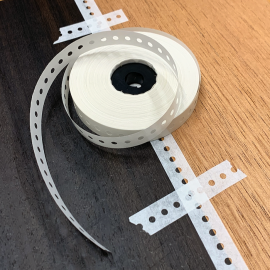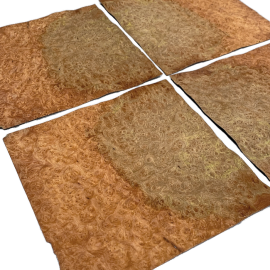
Red Elm Burl Veneers 110 x 32 cm
Red Elm Burl Veneers 110 x 32 cm
Genuine wood sliced-veneer sheets, in sequence.
Length: 110 cm.
Width: 32 cm.
Thickness: 0.63 mm.
Sold by the sheet.
These photos are taken from the veneer sheets you will receive.
Red Elm Burl Veneers 110 x 32 cm
Genuine wood sliced-veneer sheets, in sequence.
Dimensions:
Length: 110 cm.
Width: 32 cm.
Thickness: 0.63 mm.
Measurement scaling:
The width and the length are rounded to the covered centimeter. For example, 15.8 cm is given 15 cm.
Pictures:
These photos are taken from the veneer sheets you will receive.
While we strive to capture colors as accurately as possible, please note that the colors may vary slightly from the photo. The screen on which you view the photos can also affect their appearance.
What are burl and cluster veneers?
Burl and cluster veneers are rare and reserved for prestigious projects.
Burl veneer is composed of grouped pinknots, which are densely packed and usually cover a good portion of the veneer sheet.
Cluster veneer, on the other hand, is characterized by the wild movement of its wood grain. However, clusters can also have pin-knots, either isolated or in clusters.
Numerous pin knots mean some pin knots are piercing, and open cracks are considered a natural part of this type of wood.
After gluing, you can fill the small holes with wood putty for a complete finish. Alternatively, before gluing, cut out the larger holes with a cookie cutter and insert a veneer disc of the same size, taken from a scrap.
By nature, burl or cluster veneer has a lot of end grain, so its sheets are often warped. Even when they have been pressed, they may still be slightly warped.
However, it is necessary to differentiate between the two types of waving:
Hard waving makes a "pop" sound when you press on them with your finger.
In this case, it's advisable to flatten the veneers before using them. There are several methods; please inquire.
Soft waving, doesn't make any noise.
In this case, there is no major problem; however, if you want to join multiple sheets together, it's better to press them beforehand.
What is Red Elm Wood?
What are the common Names for Red Elm Wood?
Red Elm, American red Elm, US red Elm.
What is the botanical name for Red Elm Wood?
Ulmus rubra.
Where can we find Red Elm in nature?
Red Elm is endemic to North America, from the banks of the St. Lawrence River to northern Texas.
How to Recognize Red Elm Wood?
It is a wood with an orange/reddish-brown color.
The characteristic that allows one to recognize an elm wood, whether it is from North America, Europe, or Asia, is the pattern found between each hollow vein, obvious on flat-cut veneers, and almost invisible on quarter-cut veneers.
This pattern is called "jay feather" and resembles the colorful tail of the bird of the same name. However, the more scientific term for this particularity is festooned parenchyma.
What are the mechanical properties of Red Elm Wood?
Weight: 600 Kg/m3, average at 10-12% humidity.
Janka Hardness: 3830 Newton. For comparison, Oak is 4980 N, and Poplar is 1650 N.
Modulus of Elasticity: 10.28 GigaPascal; for comparison: Ash 12.31 GPa and Poplar 9.75 GPa.
Crushing Strength: 89 MegaPascal, for comparison: US Maple is 109 MPa and Yew is 96 MPa.
What are the uses of Red Elm veneers?
Traditionally, Elm is a wood used as timber; its technical characteristics make it an ideal wood for framing and furniture making.
In the form of sliced veneer, elm is used in furniture making, as well as in decoration.
But it is in the form of burl that it is used in automotive cabinetmaking; it is a classic in English cars.
What are Wood Veneers?
Veneers are thin sheets of wood obtained by slicing or peeling.
Their surface has the appearance of planed wood without any finish or treatment. They are neither glued nor backed with any other material. This means that both faces of the sheets can be used.
Wood Veneers are mainly used to cover less aesthetic substrates, such as plywood or particleboard, to make furniture or wall panels.
Veneers are also used to create decorative objects such as lamps, jewelry, bookmarks, and more.
By assembling several sheets of veneer on top of each other, it is possible to manufacture objects requiring high mechanical resistance, such as skis, bicycle frames, or musical instruments.
The applications of veneer are as varied as they are multiple.
Since veneers are made of genuine wood, all wood finishing products, such as varnish, stain, or oil, are suitable. The choice of finish will depend on your personal preferences and the object's intended use.
The veneer offered here is a sliced sheet of uniform thickness, but the thickness might differ from one species to another. The standard thickness is around 0.6 mm.
Although the edges of the veneers have been cut roughly straight, they are not perfectly parallel. Some veneers may retain the natural taper of the tree, being slightly wider at the foot than at the top.
Some veneers may have a slight wavy edge (one that follows the tree's natural shape) on the sides. In this case, the indicated dimensions correspond to the minimum width of the veneer, as specified in the "Dimensions" section.
How to use veneers?
How to cut the veneers?
Veneers can be easily cut with a utility knife.
For straight cuts, the best results are obtained with a veneer saw.
Use a fretsaw, scalpel, or veneer knife for curved cuts.
Always allow for a slightly larger veneer sheet than your intended surface. This will allow you to adjust the size after gluing for a clean finish.
A flush trimmer can also be used to trim the veneer after it has been glued.
When cutting with a utility knife or veneer knife, it is best to cut with the grain of the wood. To check this, run your finger along the edge of the sheet. The direction that feels smoothest is the ideal direction for cutting.
What is veneer splicing?
Since veneers come in the width that nature gave us, you may need to cover an area wider than the available veneers.
Therefore, you need to splice the veneers by gluing or fixing them side by side with tape to achieve the desired width.
Trim the veneer's edges with a straight, smooth cut to achieve a good joint.
Stick the veneers in place with tape (the blue one is a good choice).
Usually, the veneers are spliced side by side, but to obtain a longer length, they can be spliced foot versus foot.
The splicing must be done before gluing the veneers on the substrate.
What Glue to Use for Veneering?
Several types of gluing are possible.
Vinylic glue (PVA or PVB) is well-suited for porous substrates such as plywood, particleboard, or MDF. The veneers must be pressed with clamps over the entire surface at once.
Note: A technique using vinylic glue and an iron can also be used to glue veneers, but we strongly recommend using this technique only if other gluing solutions are not possible.
- Neoprene glue is applied to all surfaces, especially non-porous surfaces, using two coats of glue and marouflage.
- Animal glue, such as hide, sinew, or bone glue, is a product that must be cooked in a double boiler and used hot.
How to Sand Veneers?
Veneers and all our products are genuine wood and can be sanded accordingly to the thickness.
Please do not use a belt sander, regardless of the veneer's thickness, as this could pierce it.
With a 0.6 mm veneer, lightly sand with 120 grit and then finish with 180 or 240 grit. With an orbital sander, 180 grit is already sufficient for most applications.
How to Finish a Veneer Realization?
All finishing products generally used for wood are suitable for finishing our products. For example, you can use a varnish, wax, paint, or oil.
However, ensure that the product you want to use is compatible with the final use of your creation.
More information:
Please look at our TUTORIALS; you might find some valuable tips.
Please contact us by email or phone for any additional information.
Data sheet
- Species
- Elm
- Thickness group
- Standard
- Grade
- Burl
You might also like
 English
English









